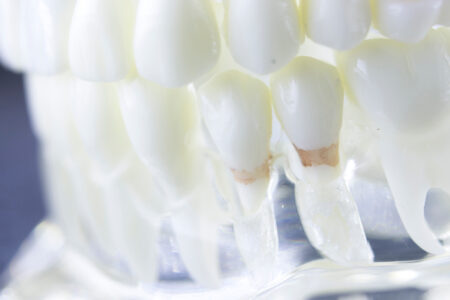 Issues with gum infection and inflammation are incredibly common, but still bring a sharp stigma. In order to avoid seeking care, many people will change the way they speak or eat simply in order to hide their smile. But over 40% of Americans over the age of 30 have some form of periodontal disease, or the term for this condition.
Issues with gum infection and inflammation are incredibly common, but still bring a sharp stigma. In order to avoid seeking care, many people will change the way they speak or eat simply in order to hide their smile. But over 40% of Americans over the age of 30 have some form of periodontal disease, or the term for this condition.
Our periodontal tissue helps to protect our mouths, and when they are weakened, our overall health can suffer significantly. When the gums pull back and expose the root, your tooth may become infected as well. This ultimately leads to a root canal or even an extraction. Today, your Overland Park, KS dentist writes on some of the ways we can treat this once it has started, and how best to avoid it to begin with!
Don’t Shy Away!
Often, the first reaction to gum recession is to hide the affected area. Maybe if you just leave it alone, it will correct itself. That is highly unlikely to occur, and by ignoring the problem, you may be allowing the bacteria to grow unimpeded.
But don’t feel embarrassed by your condition! The first step is seeking treatment, and if you are hiding behind shame, you may not be mentally able to take that initial move. So relax, understand that many people deal with this same scenario.
Grafting Can Help
If you have significant periodontal disease, your dentist will most likely suggest a gum graft to correct the situation. Beacterial infection within this tissue is very difficult to fight, so surgical maneuvers are more successful than medicinal ones.
A free gingival graft is the most common form of this procedure. Initially, your trained oral healthcare professional will clean the site, and remove all damaged tissue. This is necessary to prevent the possibility of re-infection. Nobody wants to lose this material, but it is a needed step in healing. The best way to save your natural gum tissue is through prevention. Every moment you wait means damage that is currently being done!
Your tissue is then pulled up and attached, stretching the matter so that it covers the full area. If you need more tissue than is available at that location, we will identify a secondary donor spot. Usually this is on the roof of the mouth or the soft palate. Using the same concept, some periodontal tissue is taken from there and then placed into your damaged area.
After the procedure, you will need to stick with a soft diet for around a week. Each mouth is different, so be sure to follow all the advice your dentist gives you. But you should be able to resume normal activities soon after your surgery. Keep an open line of communication open with the office during recovery, as well!
Call Us For More Information!
Contact Family First Dental in Overland Park, KS by calling 913-381-2600 to schedule your next appointment with our team and discuss how we can plan to protect your teeth as best as possible!
